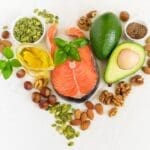Why Vegetable and Seed Oils Are Harmful
Vegetable and seed oils are packed with omega-6 fatty acids. While our bodies do need some omega-6s, too much can lead to chronic inflammation. Chronic inflammation has been linked to a host of health problems, including heart disease, obesity, diabetes, and even certain cancers. Plus, these oils are often processed at high temperatures, which can create harmful compounds like trans fats and free radicals. Yikes!
Where You’ll Find Vegetable and Seed Oils
These oils are sneaky and can be found in many of our favorite foods. Here are some common culprits:
- Processed Foods: Many packaged snacks, cookies, and ready-to-eat meals list vegetable oils as a primary ingredient.
- Fried Foods: Think fast food favorites like fries, fried chicken, and onion rings.
- Salad Dressings and Sauces: Store-bought dressings, mayonnaise, and many sauces often use these oils.
- Margarine and Spreads: These often contain vegetable oils, which are high in harmful trans fats.
Restaurants Known for Using Vegetable and Seed Oils
Fast food chains and many casual dining spots rely heavily on vegetable and seed oils, mostly because they’re cheap and can withstand high cooking temperatures. Some notable examples include:
- McDonald’s: Their fries and many other fried items are cooked in a blend of vegetable oils.
- KFC: The famous fried chicken is prepared using vegetable oil blends.
- Subway: Many of their sauces and dressings use soybean oil.
- Chick-fil-A: Known for using peanut oil for their fried chicken, but many of their other menu items, such as salad dressings and sauces, contain soybean oil.
- Wendy’s: Uses vegetable oils for frying and in various sauces and dressings.
Healthier Alternatives You Should Consider
So, what should you use instead? Here are some healthier options that can make a big difference:
- Olive Oil: This is a fantastic option for salad dressings, sautéing, and low-heat cooking. It’s rich in monounsaturated fats and antioxidants.
- Coconut Oil: Perfect for baking, frying, and even adding to your morning coffee, coconut oil is stable at high temperatures and contains beneficial medium-chain triglycerides (MCTs).
- Avocado Oil: High in monounsaturated fats, avocado oil is great for high-heat cooking and has a mild flavor that works well in many dishes.
- Animal Fats: Butter, ghee, and tallow are excellent choices, especially for high-heat cooking. They add a delicious flavor and have beneficial fats that our bodies can easily use. If you’re interested in trying Tallow, you can buy it here.

By making these simple swaps, you can significantly reduce your intake of harmful fats and boost your overall health. It’s surprising how such a simple change can have such a large impact. So next time you’re in the kitchen, reach for the olive oil, coconut oil, avocado oil, or even a bit of butter, ghee, or tallow. Your body will thank you for it.













